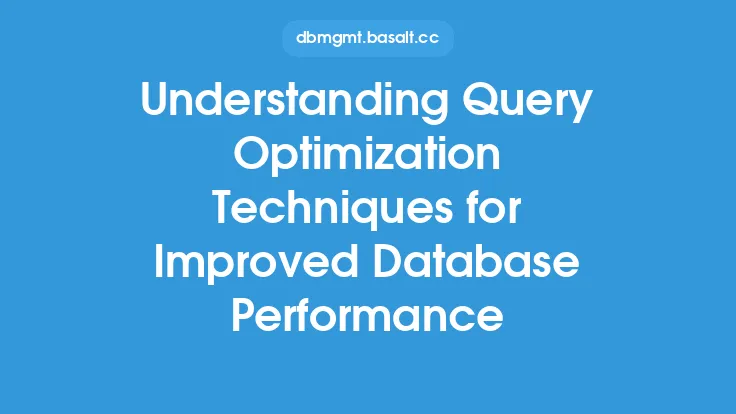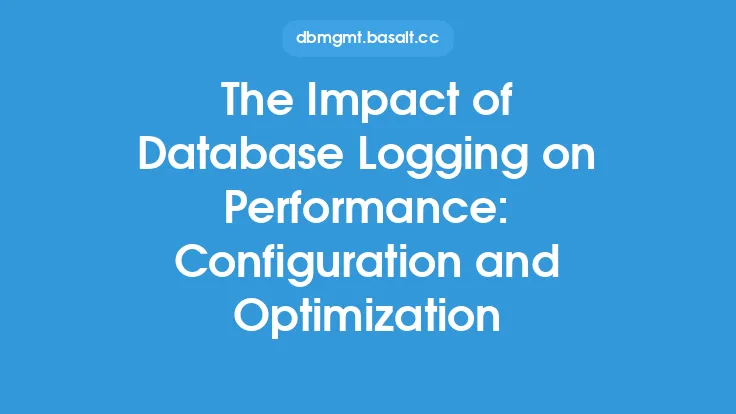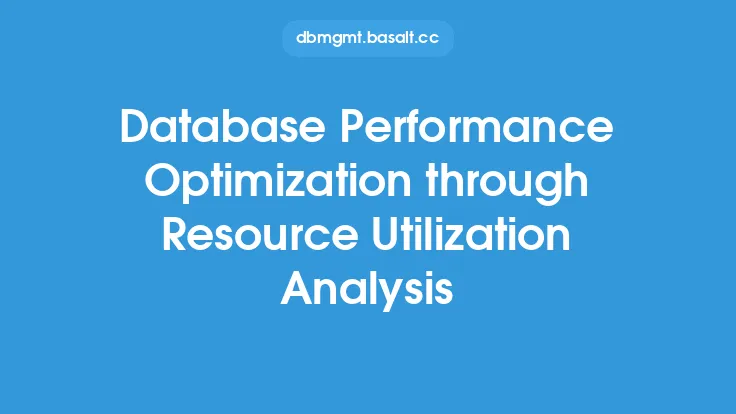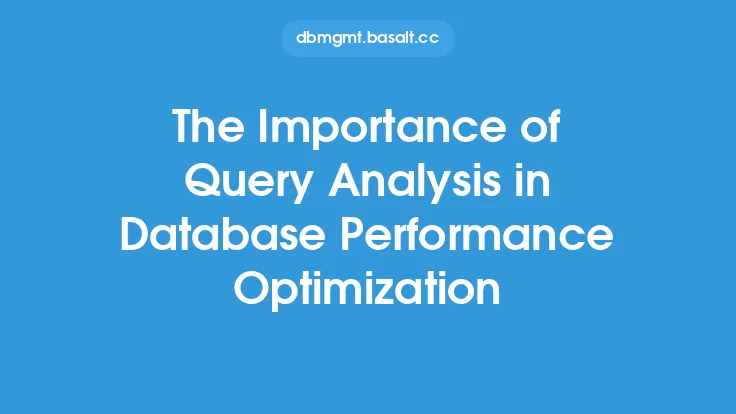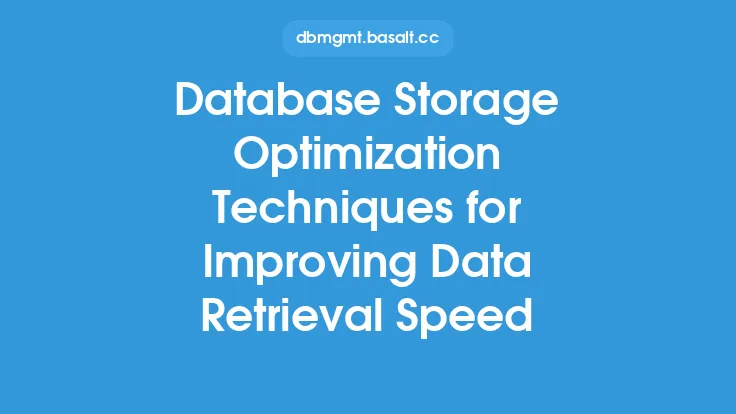Database performance optimization is a critical aspect of database administration, as it directly impacts the overall efficiency and responsiveness of an application or system. A well-optimized database can significantly improve data retrieval and manipulation speeds, reduce latency, and increase throughput, ultimately leading to a better user experience. In this article, we will delve into the various techniques and strategies used to optimize database performance, exploring the underlying principles and best practices that database administrators can employ to ensure their databases run at peak efficiency.
Introduction to Database Performance Optimization
Database performance optimization involves a combination of techniques, tools, and methodologies aimed at improving the speed, efficiency, and reliability of database operations. This can include query optimization, indexing, caching, partitioning, and other strategies that help reduce the time it takes to execute database queries and perform other operations. By optimizing database performance, administrators can improve the overall responsiveness of their applications, reduce the risk of errors and downtime, and increase user satisfaction.
Query Optimization Techniques
Query optimization is a critical aspect of database performance optimization, as it involves analyzing and improving the efficiency of database queries. This can be achieved through various techniques, including:
- Query analysis: This involves examining query execution plans, identifying performance bottlenecks, and optimizing query syntax to reduce the number of database operations required.
- Indexing: Indexing involves creating data structures that facilitate faster data retrieval, reducing the time it takes to execute queries. This can include creating indexes on frequently accessed columns, using composite indexes, and maintaining index statistics.
- Caching: Caching involves storing frequently accessed data in memory, reducing the need for disk I/O operations and improving query performance. This can include using query caches, result caches, and other caching mechanisms.
- Query rewriting: This involves rewriting queries to improve performance, such as using more efficient join algorithms, reducing the number of subqueries, and optimizing aggregate functions.
Indexing and Partitioning Strategies
Indexing and partitioning are two closely related strategies used to improve database performance. Indexing, as mentioned earlier, involves creating data structures that facilitate faster data retrieval, while partitioning involves dividing large tables into smaller, more manageable pieces. This can include:
- Range-based partitioning: This involves dividing tables based on a specific range of values, such as date or timestamp.
- List-based partitioning: This involves dividing tables based on a specific list of values, such as a list of countries or regions.
- Hash-based partitioning: This involves dividing tables based on a hash function, which distributes data evenly across multiple partitions.
- Composite indexing: This involves creating indexes on multiple columns, which can improve query performance by reducing the number of index scans required.
Database Configuration and Tuning
Database configuration and tuning involve adjusting database settings and parameters to optimize performance. This can include:
- Buffer pool sizing: This involves adjusting the size of the buffer pool, which can improve performance by reducing the number of disk I/O operations required.
- Sort buffer sizing: This involves adjusting the size of the sort buffer, which can improve performance by reducing the number of sort operations required.
- Join buffer sizing: This involves adjusting the size of the join buffer, which can improve performance by reducing the number of join operations required.
- Lock timeout settings: This involves adjusting lock timeout settings, which can improve performance by reducing the risk of deadlocks and other concurrency issues.
Storage and I/O Optimization
Storage and I/O optimization involve optimizing the underlying storage and I/O subsystems to improve database performance. This can include:
- Disk configuration: This involves configuring disk arrays, RAID levels, and other storage settings to optimize performance.
- Storage area networks (SANs): This involves using SANs to improve storage performance, reduce latency, and increase throughput.
- Solid-state drives (SSDs): This involves using SSDs to improve storage performance, reduce latency, and increase throughput.
- I/O scheduling: This involves optimizing I/O scheduling algorithms to reduce latency, increase throughput, and improve overall system performance.
Monitoring and Troubleshooting
Monitoring and troubleshooting are critical aspects of database performance optimization, as they involve identifying and resolving performance issues before they impact users. This can include:
- Performance monitoring tools: This involves using tools such as SQL Server Management Studio, Oracle Enterprise Manager, or MySQL Workbench to monitor database performance.
- Query analysis tools: This involves using tools such as SQL Server Query Store, Oracle SQL Tuning Advisor, or MySQL Query Analyzer to analyze and optimize queries.
- Error logging and analysis: This involves analyzing error logs to identify and resolve performance issues, such as deadlocks, timeouts, and other concurrency issues.
- Benchmarking and testing: This involves benchmarking and testing database performance to identify bottlenecks, optimize configuration settings, and improve overall system performance.
Best Practices and Recommendations
To optimize database performance, administrators should follow best practices and recommendations, such as:
- Regularly maintaining database statistics: This involves updating database statistics to ensure that the query optimizer has accurate information to make informed decisions.
- Running regular backups and maintenance tasks: This involves running regular backups, checking for errors, and performing other maintenance tasks to ensure database integrity and performance.
- Monitoring database performance: This involves monitoring database performance regularly to identify and resolve performance issues before they impact users.
- Optimizing database configuration settings: This involves optimizing database configuration settings, such as buffer pool size, sort buffer size, and join buffer size, to improve performance.
- Using indexing and partitioning strategies: This involves using indexing and partitioning strategies to improve query performance, reduce latency, and increase throughput.
Conclusion
Database performance optimization is a critical aspect of database administration, as it directly impacts the overall efficiency and responsiveness of an application or system. By employing various techniques and strategies, such as query optimization, indexing, caching, partitioning, and storage and I/O optimization, administrators can improve database performance, reduce latency, and increase throughput. Additionally, following best practices and recommendations, such as regularly maintaining database statistics, running regular backups and maintenance tasks, monitoring database performance, optimizing database configuration settings, and using indexing and partitioning strategies, can help ensure that databases run at peak efficiency and provide a better user experience.
